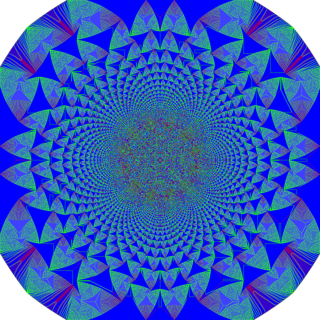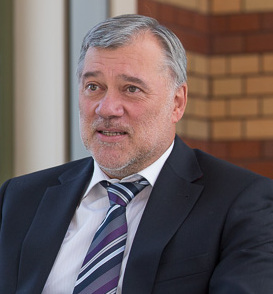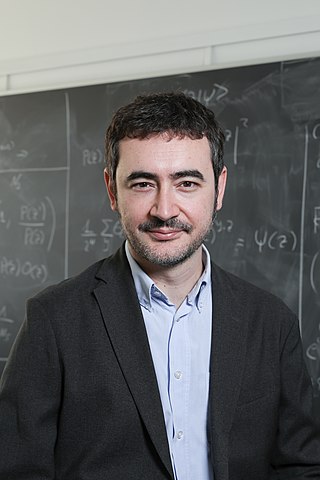
A scale-free network is a network whose degree distribution follows a power law, at least asymptotically. That is, the fraction P(k) of nodes in the network having k connections to other nodes goes for large values of k as

Self-organized criticality (SOC) is a property of dynamical systems that have a critical point as an attractor. Their macroscopic behavior thus displays the spatial or temporal scale-invariance characteristic of the critical point of a phase transition, but without the need to tune control parameters to a precise value, because the system, effectively, tunes itself as it evolves towards criticality.

Albert-László Barabási is a Romanian-born Hungarian-American physicist, best known for his discoveries in network science and network medicine.

In the context of network theory, a complex network is a graph (network) with non-trivial topological features—features that do not occur in simple networks such as lattices or random graphs but often occur in networks representing real systems. The study of complex networks is a young and active area of scientific research inspired largely by empirical findings of real-world networks such as computer networks, biological networks, technological networks, brain networks, climate networks and social networks.
Harry L. Swinney is an American physicist noted for his contributions to the field of nonlinear dynamics.

In network science, reciprocity is a measure of the likelihood of vertices in a directed network to be mutually linked. Like the clustering coefficient, scale-free degree distribution, or community structure, reciprocity is a quantitative measure used to study complex networks.
Network dynamics is a research field for the study of networks whose status changes in time. The dynamics may refer to the structure of connections of the units of a network, to the collective internal state of the network, or both. The networked systems could be from the fields of biology, chemistry, physics, sociology, economics, computer science, etc. Networked systems are typically characterized as complex systems consisting of many units coupled by specific, potentially changing, interaction topologies.
Human dynamics refer to a branch of complex systems research in statistical physics such as the movement of crowds and queues and other systems of complex human interactions including statistical modelling of human networks, including interactions over communications networks.
Alfred Wilhelm Hübler was a German-born research physicist at the University of Illinois at Urbana-Champaign (UIUC) Frederick Seitz Materials Research Laboratory as well as a tenured faculty member in the University of Illinois Department of Physics. He was the director of the Center for Complex Systems Research (CCSR) and an external faculty member of the Santa Fe Institute.
In social network analysis, the co-stardom network represents the collaboration graph of film actors i.e. movie stars. The co-stardom network can be represented by an undirected graph of nodes and links. Nodes correspond to the movie star actors and two nodes are linked if they co-starred (performed) in the same movie. The links are un-directed, and can be weighted or not depending on the goals of study. If the number of times two actors appeared in a movie is needed, links are assigned weights. The co-stardom network can also be represented by a bipartite graph where nodes are of two types: actors and movies. And edges connect different types of nodes if they have a relationship. Initially the network was found to have a small-world property. Afterwards, it was discovered that it exhibits a scale-free (power-law) behavior.

Jürgen Kurths is a German physicist and mathematician. He is senior advisor in the research department Complexity Sciences of the Potsdam Institute for Climate Impact Research, a Professor of Nonlinear Dynamics at the Institute of Physics at the Humboldt University, Berlin, and a 6th-century chair for Complex Systems Biology at the Institute for Complex Systems and Mathematical Biology at Kings College, Aberdeen University (UK). His research is mainly concerned with nonlinear physics and complex systems sciences and their applications to challenging problems in Earth system, physiology, systems biology and engineering.
Robustness, the ability to withstand failures and perturbations, is a critical attribute of many complex systems including complex networks.
In fluid dynamics, the Frenkel line is a proposed boundary on the phase diagram of a supercritical fluid, separating regions of qualitatively different behavior. Fluids on opposite sides of the line have been described as "liquidlike" or "gaslike", and exhibit different behaviors in terms of oscillation, excitation modes, and diffusion.

The Bianconi–Barabási model is a model in network science that explains the growth of complex evolving networks. This model can explain that nodes with different characteristics acquire links at different rates. It predicts that a node's growth depends on its fitness and can calculate the degree distribution. The Bianconi–Barabási model is named after its inventors Ginestra Bianconi and Albert-László Barabási. This model is a variant of the Barabási–Albert model. The model can be mapped to a Bose gas and this mapping can predict a topological phase transition between a "rich-get-richer" phase and a "winner-takes-all" phase.
Dynamic scaling is a litmus test that shows whether an evolving system exhibits self-similarity. In general a function is said to exhibit dynamic scaling if it satisfies:
Entropy networks have been investigated in many research areas, on the assumption that entropy can be measured in a network. The embodiment of the network is often physical or informational. An entropy network is composed of entropy containers which are often called nodes, elements, features, or regions and entropy transfer occurs between containers. The transfer of entropy in networks was characterized by Schreiber in his transfer entropy.
Shortcuts to adiabaticity (STA) are fast control protocols to drive the dynamics of system without relying on the adiabatic theorem. The concept of STA was introduced in a 2010 paper by Xi Chen et al. Their design can be achieved using a variety of techniques. A universal approach is provided by counterdiabatic driving, also known as transitionless quantum driving. Motivated by one of authors systematic study of dissipative Landau-Zener transition, the key idea was demonstrated earlier by a group of scientists from China, Greece and USA in 2000, as steering an eigenstate to destination. Counterdiabatic driving has been demonstrated in the laboratory using a time-dependent quantum oscillator.
Stefano Boccaletti is an Italian physicist. He is senior researcher at the CNR's Institute for Complex Systems in Florence, Italy. His research is mainly concerned with nonlinear and statistical physics, and complex systems sciences with applications to systems biology and systems medicine, data and networks sciences, social science and engineering, among others.
Applying classical methods of machine learning to the study of quantum systems is the focus of an emergent area of physics research. A basic example of this is quantum state tomography, where a quantum state is learned from measurement. Other examples include learning Hamiltonians, learning quantum phase transitions, and automatically generating new quantum experiments. Classical machine learning is effective at processing large amounts of experimental or calculated data in order to characterize an unknown quantum system, making its application useful in contexts including quantum information theory, quantum technologies development, and computational materials design. In this context, it can be used for example as a tool to interpolate pre-calculated interatomic potentials or directly solving the Schrödinger equation with a variational method.

Giuseppe Carleo is an Italian physicist. He is a professor of computational physics at EPFL and the head of the Laboratory of Computational Quantum Science.







